
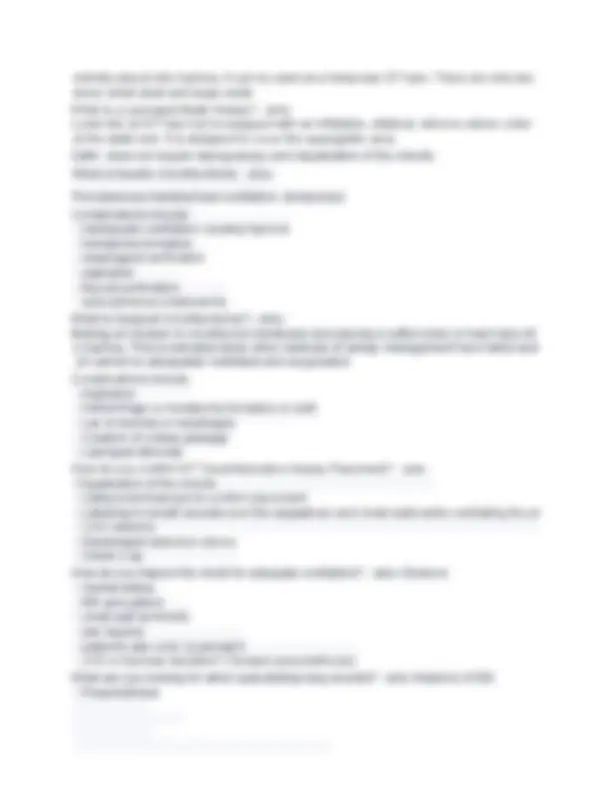
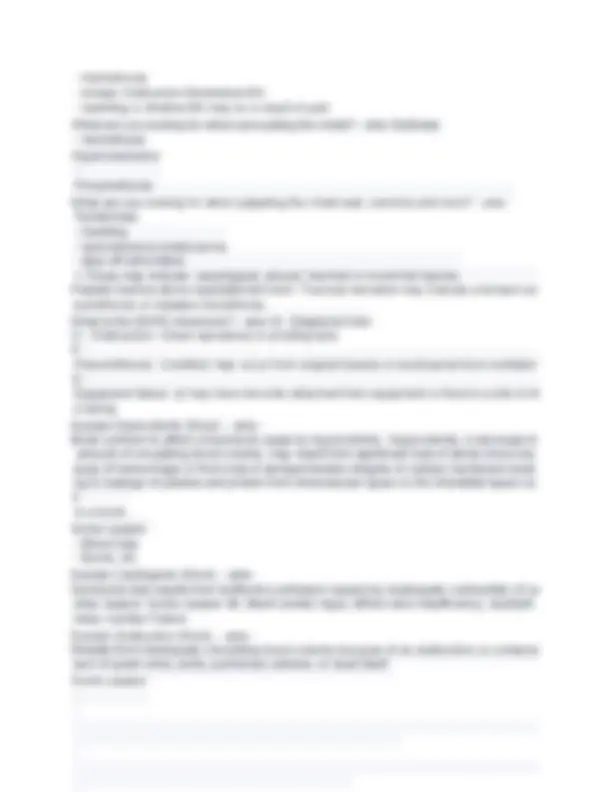
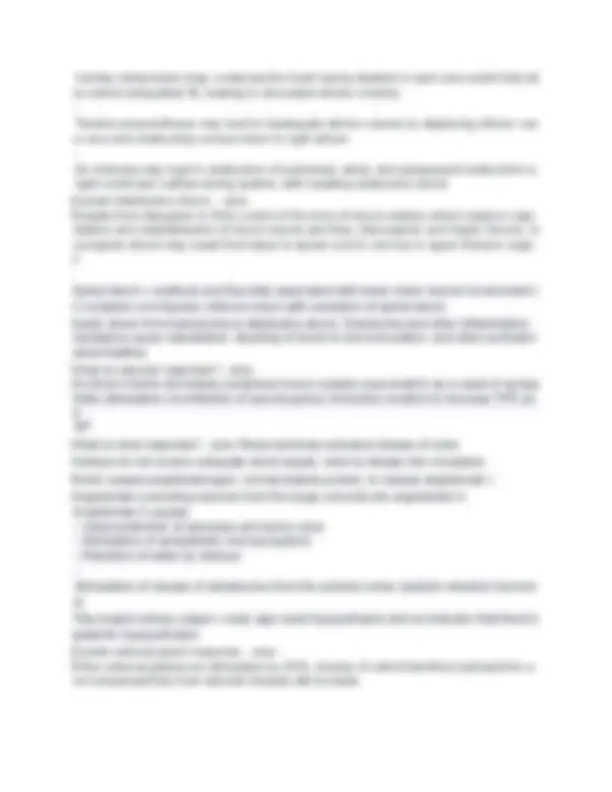
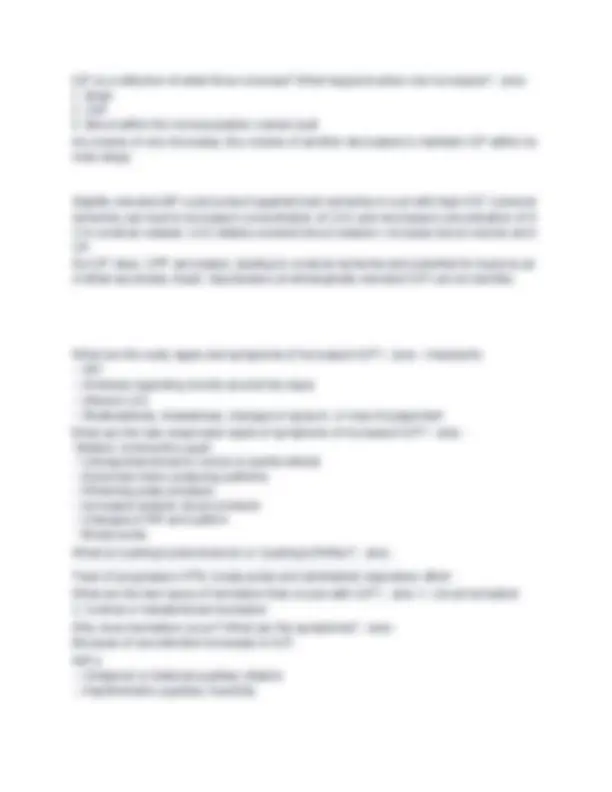

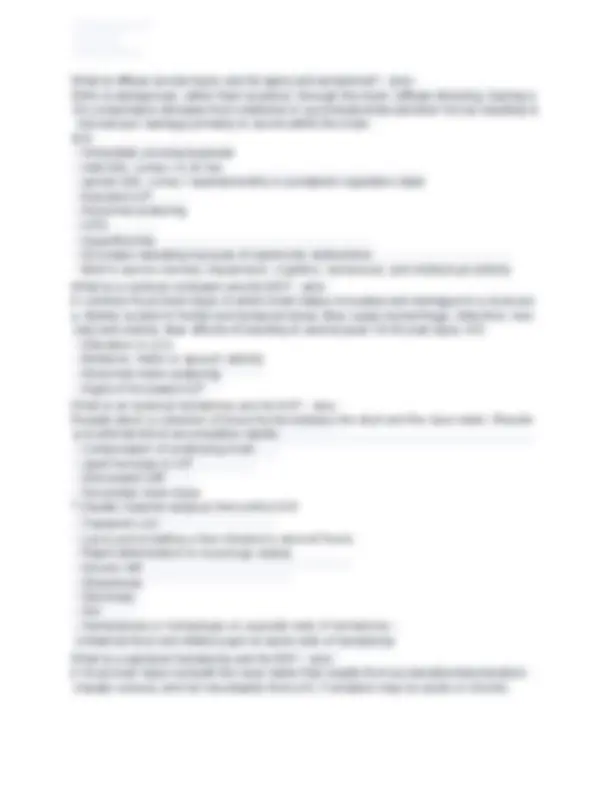
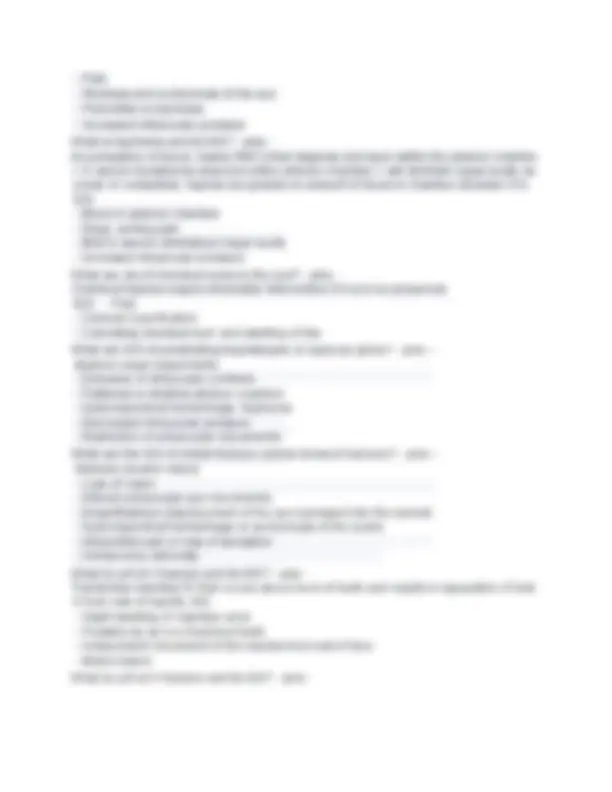
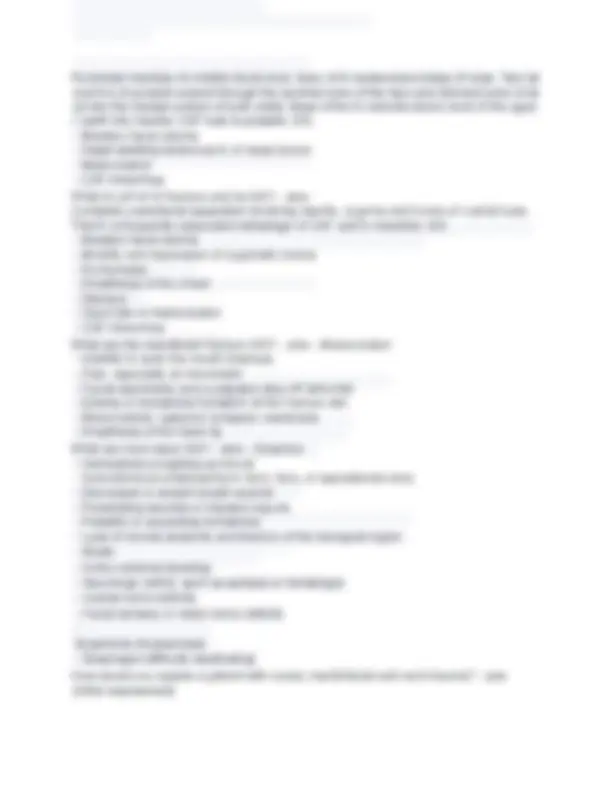
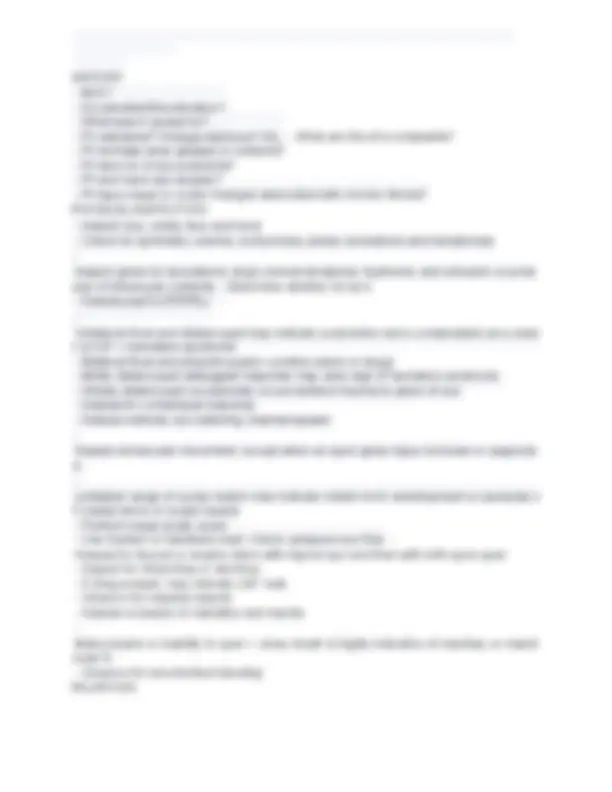
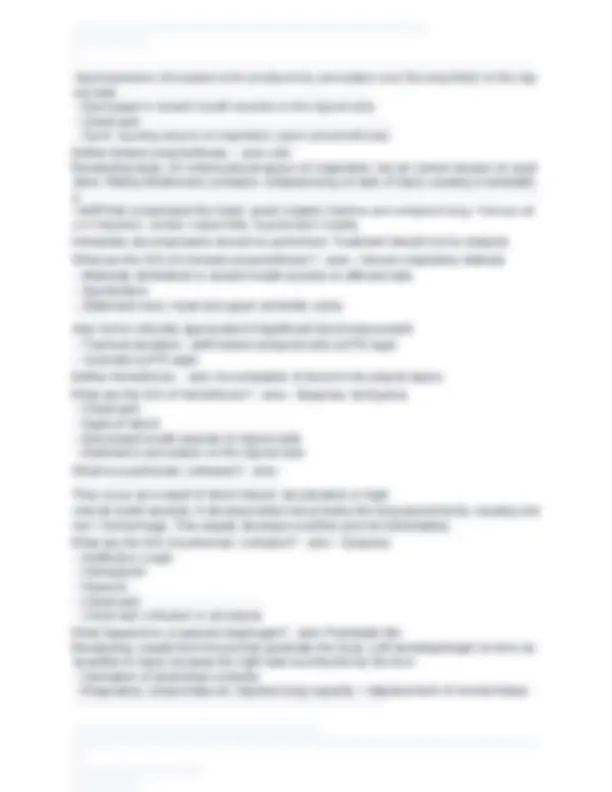
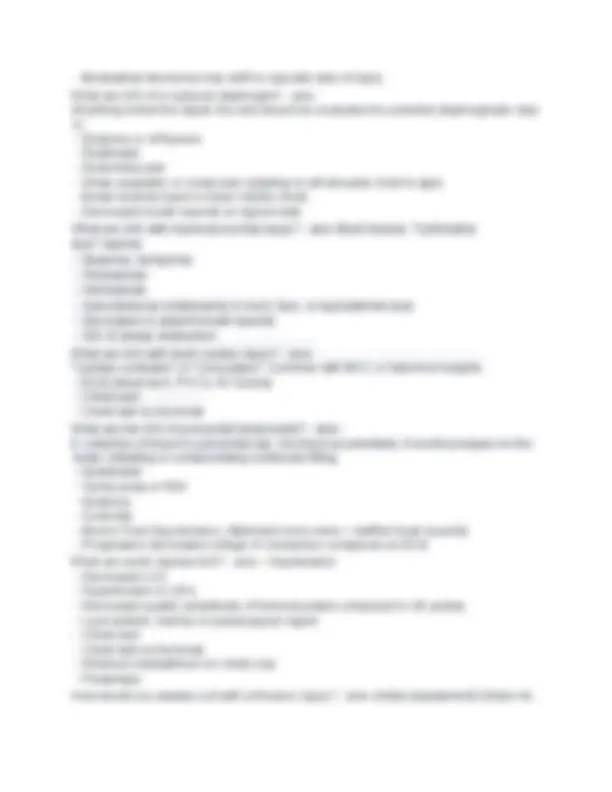
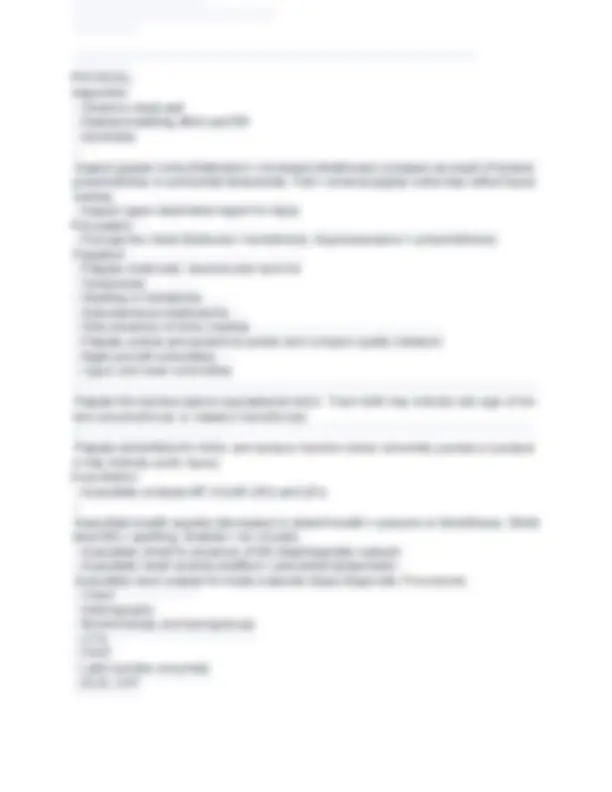
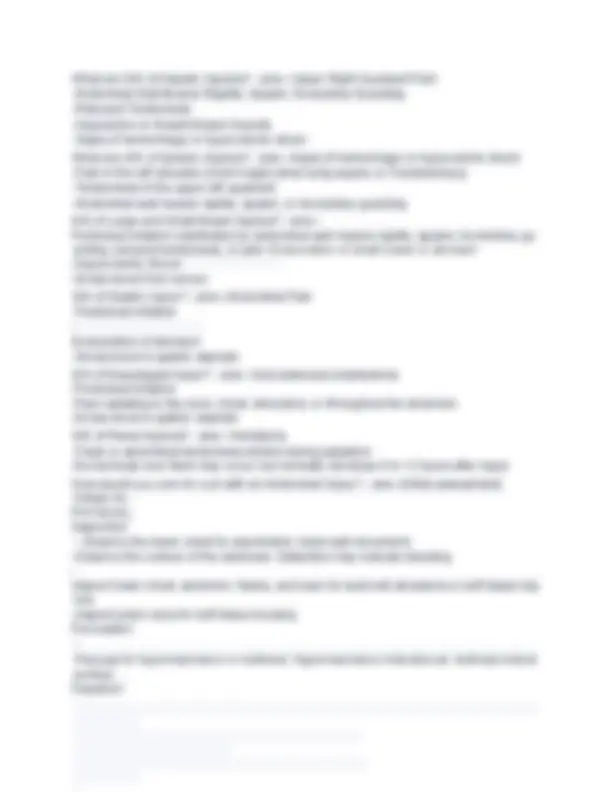
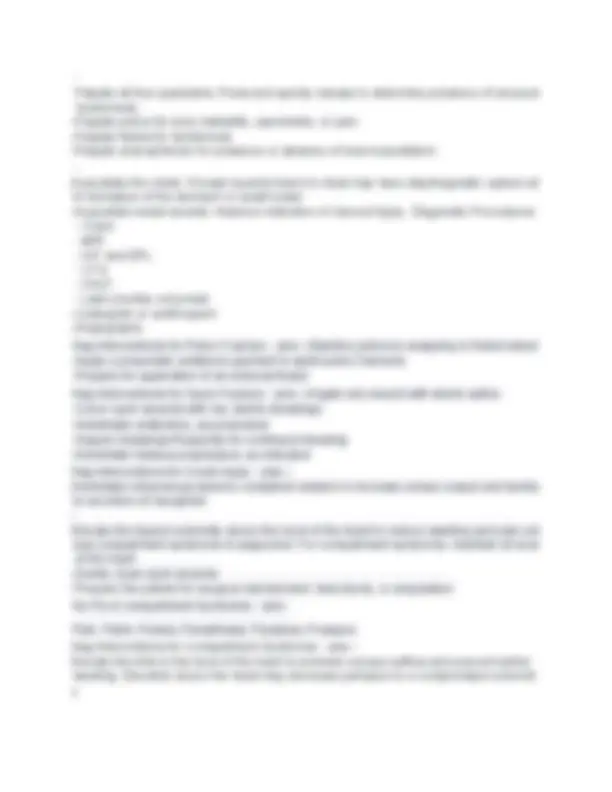



Study with the several resources on Docsity

Earn points by helping other students or get them with a premium plan


Prepare for your exams
Study with the several resources on Docsity

Earn points to download
Earn points by helping other students or get them with a premium plan
Community
Ask the community for help and clear up your study doubts
Discover the best universities in your country according to Docsity users
Free resources
Download our free guides on studying techniques, anxiety management strategies, and thesis advice from Docsity tutors
A comprehensive set of questions and answers related to the tncc (trauma nursing core course) exam. It covers various aspects of trauma nursing, including airway management, circulation, ventilation, shock, and more. Designed to help students prepare for the tncc exam by providing a structured approach to learning and reviewing key concepts.
Typology: Exams
1 / 23

This page cannot be seen from the preview
Don't miss anything!
















i!l i!l i!l i!l i!l i!l What 6 are 6 the 6 late 6 signs 6 of 6 breathing 6 compromise? 6 - 6 ans--- 6 Tracheal 6 deviation 6 - 6 JVD i!l i!l What 6 are 6 signs 6 of 6 ineffective 6 breathing? 6 - 6 ans--- 6 AMS i!l 6 - 6 Cyanosis, 6 especially 6 around 6 the 6 mouth i!l 6 - 6 Asymmetric 6 expansion 6 of 6 chest 6 wall i!l 6 - 6 Paradoxical 6 movement 6 of 6 the 6 chest 6 wall 6 during 6 inspiration 6 and 6 expiration i!l 6 - 6 Use 6 of 6 accessory 6 muscles 6 or 6 abdominal 6 muscles 6 or 6 both 6 or 6 diaphragmatic 6 breathing i!l 6 - 6 Sucking 6 chest 6 wounds 6 i!l 6 - 6 Absent 6 or 6 diminished 6 breath 6 sounds i!l 6 - 6 Administer 6 O2 6 via 6 NRB 6 or 6 assist 6 ventilations 6 with 6 a 6 bag-mask 6 device, 6 as 6 indicated i!l 6 - (^6) i!lAnticipate 6 definitive 6 airway 6 management 6 to 6 support 6 ventilation. i!l Upon 6 initial 6 assessment, 6 what 6 type 6 of 6 oxygen 6 should 6 be 6 used 6 for 6 a 6 pt 6 breathing 6 effective ly? 6 - 6 ans--A 6 tight-fitting 6 nonrebreather 6 mask 6 at 612 - 156 lpm. i!l i!l What 6 intervention 6 should 6 be 6 done 6 if 6 a 6 pt 6 presents 6 with 6 effective 6 circulation? 6 - 6 ans--- 6 Insert 626 large 6 caliber 6 IV's i!l 6 - 6 Administer 6 warmed 6 isotonic 6 crystalloid 6 solution 6 at 6 an 6 appropriate 6 rate i!l i!l What 6 are 6 signs 6 of 6 ineffective 6 circulation? 6 - 6 ans--- 6 Tachycardia 6 - 6 AMS i!l 6 - 6 Uncontrolled 6 external 6 bleeding i!l 6 - 6 Pale, 6 cool, 6 moist 6 skin i!l 6 - 6 Distended 6 or 6 abnormally 6 flattened 6 external 6 jugular 6 veins i!l 6 - 6 Distant 6 heart 6 sounds i!l i!l What 6 are 6 the 6 interventions 6 for 6 Effective/Ineffective 6 Circulation? 6 - 6 ans-- 6 Control 6 any 6 uncontrolled 6 external 6 bleeding 6 by: i!l 6 - 6 Applying 6 direct 6 pressure 6 over 6 bleeding 6 site i!l 6 - 6 Elevating 6 bleeding 6 extremity i!l 6 - 6 Applying 6 pressure 6 over 6 arterial 6 pressure 6 points i!l 6 - 6 Using 6 tourniquet 6 (last 6 resort). i!l 6 - 6 Cannulate 626 large-caliber 6 IV's 6 and 6 initiate 6 infusions 6 of 6 an 6 isotonic 6 crystalloid 6 solution i!l 6 - 6 Use 6 warmed 6 solution i!l 6 - 6 Use 6 pressure 6 bags 6 to 6 increase 6 speed 6 of 6 IVF 6 infusion i!l 6 - 6 Use 6 blood 6 administration 6 tubing 6 for 6 possible 6 administration 6 of 6 blood i!l 6 - 6 Use 6 rapid 6 infusion 6 device 6 based 6 on 6 protocol i!l 6 - 6 Use 6 NS 6 0.9% 6 in 6 same 6 tubing 6 as 6 blood 6 product i!l 6 - 6 IV 6 = 6 surgical 6 cut- down, 6 central 6 line, 6 or 6 both. i!l 6 - 6 Blood 6 sample 6 to 6 determine 6 ABO 6 and 6 Rh 6 group i!l 6 - 6 IO 6 in 6 sternum, 6 legs, 6 arms 6 or 6 pelvis i!l 6 - 6 Administer 6 blood 6 products i!l
6 - 6 PASG 6 (without 6 interfering 6 with 6 fluid 6 resuscitation) i!l i!l What 6 are 6 factors 6 that 6 contribute 6 to 6 ineffective 6 ventilation? 6 - 6 ans--- 6 AMS i!l 6 - 6 LOC i!l 6 - 6 Neurologic 6 injury i!l 6 - 6 Spinal 6 Cord 6 Injury i!l 6 - 6 Intracranial 6 Injury i!l 6 - 6 Blunt 6 trauma i!l 6 - 6 Pain 6 caused 6 by 6 rib 6 fractures i!l 6 - 6 Penetrating 6 Trauma i!l 6 - 6 Preexisting 6 hx 6 of 6 respiratory 6 diseases i!l (^6) i!l- 6 Increased 6 age i!l What 6 medications 6 are 6 used 6 during 6 intubation? 6 - 6 ans--LOAD 6 Mnemonic: i!l 6 L 6 = 6 Lidocaine i!l 6 O 6 = 6 Opioids i!l 6 A 6 = 6 Atropine i!l (^6) i!lD 6 = 6 Defasiculating 6 agents i!l What 6 are 6 the 6 Rapid 6 Sequence 6 Intubation 6 Steps? 6 - 6 ans--PREPARATION: 6 i!l 6 - 6 gather 6 equipment, 6 staffing, 6 etc. i!l PREOXYGENATION: 6 i!l 6 - 6 Use 6 100% 6 O2 6 (prevent 6 risk 6 of 6 aspiration). i!l PRETREATMENT: 6 i!l 6 - 6 Decrease 6 S/E's 6 of 6 intubation i!l PARALYSIS 6 WITH 6 INDUCTION: 6 i!l 6 - 6 Pt 6 has 6 LOC, 6 then 6 administer 6 neuromuscular 6 blocking 6 agent i!l PROTECTION 6 AND 6 POSITIONING: 6 i!l 6 - 6 Apply 6 pressure 6 over 6 cricoid 6 cartilage 6 (minimizes 6 likelihood 6 of 6 vomiting 6 and 6 aspiration i!l PLACEMENT 6 WITH 6 PROOF i!l 6 - 6 Each 6 attempt 6 NOT 6 to 6 exceed 6306 seconds, 6 max 6 of 636 attempts. 6 Ventilate 6 pt 630606 second s 6 between 6 attempts. i!l 6 - 6 After 6 intubation, 6 inflate 6 the 6 cuff i!l 6 - 6 Confirm 6 tube 6 placement 6 w/exhaled 6 CO2 6 detector. i!l POSTINTUBATION 6 MANAGEMENT: i!l 6 - 6 Secure 6 ET 6 tube i!l 6 - 6 Set 6 ventilator 6 settings i!l 6 - 6 Obtain 6 Chest 6 x-ray i!l 6 - 6 Continue 6 to 6 medicate i!l (^6) i!l- 6 Recheck 6 VS 6 and 6 pulse 6 oxtimetry What 6 is 6 a 6 Combitube? 6 - 6 ans--A 6 dual- lumen, 6 dualcuff 6 airway 6 that 6 can 6 be 6 placed 6 blindly 6 into 6 the 6 esophagus 6 to 6 establish 6 an 6 air way. 6 If 6 inadv
6 - 6 Hemothorax i!l 6 - 6 Airway 6 Obstruction i!lDiminished 6 BS: i!l 6 - 6 Splinting 6 or 6 shallow 6 BS 6 may 6 be 6 a 6 result 6 of 6 pain i!l i!l What 6 are 6 you 6 looking 6 for 6 when 6 percussing 6 the 6 chest? 6 - 6 ans--Dullness: 6 - 6 hemothorax i!l Hyperresonance i!l i!l 6 - (^6) i!lPneumothorax What 6 are 6 you 6 looking 6 for 6 when 6 palpating 6 the 6 chest 6 wall, 6 clavicles 6 and 6 neck? 6 - 6 ans-- 6 Tenderness i!l 6 - 6 Swelling i!l 6 - 6 subcutaneous 6 emphysema i!l 6 - 6 step-off 6 deformities i!l 6 = 6 These 6 may 6 indicate: 6 esophageal, 6 pleural, 6 tracheal 6 or 6 bronchial 6 injuries. i!l Palpate 6 trachea 6 above 6 suprasternal 6 notch. 6 Tracheal 6 deviation 6 may 6 indicate 6 a 6 tension 6 pn i!leumothorax i!l 6 or 6 massive 6 hemothorax. i!l What 6 is 6 the 6 DOPE 6 mnemonic? 6 - 6 ans--D 6 - 6 Displaced 6 tube i!l O 6 - 6 Obstruction: 6 Check 6 secretions 6 or 6 pt 6 biting 6 tube i!l P 6 - 6 Pneumothorax: 6 Condition 6 may 6 occur 6 from 6 original 6 trauma 6 or 6 barotrauma 6 from 6 ventilator i!lE 6 - 6 Equipment 6 failure: 6 pt 6 may 6 have 6 become 6 detached 6 from 6 equipment 6 or 6 there's 6 a 6 kink 6 in 6 th i!le i!l 6 tubing i!l Explain 6 Hypovolemic 6 Shock. 6 - 6 ans-- Most 6 common 6 to 6 affect 6 a 6 trauma 6 pt 6 cause 6 by 6 hypovolemia.. 6 Hypovolemia, 6 a 6 decrease 6 in i!l 6 amount 6 of 6 circulating 6 blood 6 volume, 6 may 6 result 6 from 6 significant 6 loss 6 of 6 whole 6 blood 6 bec i!lause 6 of 6 hemorrhage 6 or 6 from 6 loss 6 of 6 semipermeable 6 integrity 6 of 6 cellular 6 membrane 6 leadi i!lng 6 to 6 leakage 6 of 6 plasma 6 and 6 protein 6 from 6 intravascular 6 space 6 to 6 the 6 interstitial 6 space 6 (a s (^6) i!lin 6 a 6 burn). i!l Some 6 causes: i!l 6 - 6 Blood 6 loss i!l (^6) i!l- 6 Burns, 6 etc. i!l Explain 6 Cardiogenic 6 Shock. 6 - 6 ans-- Syndrome 6 that 6 results 6 from 6 ineffective 6 perfusion 6 caused 6 by 6 inadequate 6 contractility 6 of 6 ca i!lrdiac 6 muscle. 6 Some 6 causes: 6 MI, 6 Blunt 6 cardiac 6 injury, 6 Mitral 6 valve 6 insufficiency, 6 dysrhyth i!lmias, i!l 6 Cardiac 6 Failure i!l Explain 6 Obstructive 6 Shock. 6 - 6 ans-- Results 6 from 6 inadequate 6 circulating 6 blood 6 volume 6 because 6 of 6 an 6 obstruction 6 or 6 compres i!lsion 6 of 6 great 6 veins, 6 aorta, 6 pulmonary 6 arteries, 6 or 6 heart 6 itself. 6 i!l i!l Some 6 causes: i!l 6 -
6 Cardiac 6 tamponade 6 (may 6 compress 6 the 6 heart 6 during 6 diastole 6 to 6 such 6 and 6 extent 6 that 6 atr i!lia 6 cannot 6 adequately 6 fill, 6 leading 6 to 6 decreased 6 stroke 6 volume). i!l 6 - 6 Tension 6 pneumothorax 6 may 6 lead 6 to 6 inadequate 6 stroke 6 volume 6 by 6 displacing 6 inferior 6 ven i!la 6 cava 6 and 6 obstructing 6 venous 6 return 6 to 6 right 6 atrium. 6 i!l 6 - 6 Air 6 embolus 6 may 6 lead 6 to 6 obstruction 6 of 6 pulmonary 6 artery 6 and 6 subsequent 6 obstruction 6 to 6 right 6 ventricular 6 outflow 6 during 6 systole, 6 with 6 resulting 6 obstructive 6 shock i!l i!l Explain 6 Distributive 6 Shock. 6 - 6 ans-- Results 6 from 6 disruption 6 in 6 SNS 6 control 6 of 6 the 6 tone 6 of 6 blood 6 vessels, 6 which 6 leads 6 to 6 vaso i!ldilation 6 and 6 maldistribution 6 of 6 blood 6 volume 6 and 6 flow. 6 (Neurogenic 6 and 6 Septic 6 Shock). 6 N i!leurogenic 6 shock 6 may 6 result 6 from 6 injury 6 to 6 spinal 6 cord 6 in 6 cervical 6 or 6 upper 6 thoracic 6 regio n
. i!l i!l Spinal 6 shock 6 = 6 areflexia 6 and 6 flaccidity 6 associated 6 with 6 lower 6 motor 6 neuron 6 involvement 6 i n 6 complete 6 cord 6 injuries; 6 reflexes 6 return 6 with 6 resolution 6 of 6 spinal 6 shock. i!l i!l Septic 6 shock 6 from 6 bacteremia 6 is 6 distributive 6 shock. 6 Endotoxins 6 and 6 other 6 inflammatory 6 i!lmediators 6 cause 6 vasodilation, 6 shunting 6 of 6 blood 6 in 6 microcirculation, 6 and 6 other 6 perfusion 6 i!labnormalities. i!l i!l What 6 is 6 vascular 6 response? 6 - 6 ans-- As 6 blood 6 volume 6 decreases, 6 peripheral 6 blood 6 vessels 6 vasoconstrict 6 as 6 a 6 result 6 of 6 sympa i!lthetic 6 stimulation 6 via 6 inhibition 6 of 6 baroreceptors. 6 Arterioles 6 constrict 6 to 6 increase 6 TPR 6 an d 6 BP. i!l i!l What i!l 6 is 6 renal 6 response? 6 - 6 ans--Renal 6 ischemia 6 activates 6 release 6 of 6 renin. i!l Kidneys 6 do 6 not 6 receive 6 adequate 6 blood 6 supply, 6 renin 6 is 6 release 6 into 6 circulation. i!l i!l Renin i!l 6 causes 6 angiotensinogen, 6 normal 6 plasma 6 protein, 6 to 6 release 6 angiotensin 6 I. i!l Angiotensin-converting 6 enzyme 6 from 6 the 6 lungs 6 converts 6 into 6 angiotensin 6 II. 6 i!lAngiotensin 6 II 6 causes: i!l 6 - 6 Vasoconstriction 6 of 6 arterioles 6 and 6 some 6 veins i!l 6 - 6 Stimulation 6 of 6 sympathetic 6 nervous 6 system i!l 6 - 6 Retention 6 of 6 water 6 by 6 kidneys i!l 6 - 6 Stimulation 6 of 6 release 6 of 6 aldosterone 6 from 6 the 6 adrenal 6 cortex 6 (sodium 6 retention 6 hormon i!le) i!l i!l *Decreased 6 urinary 6 output 6 = 6 early 6 sign 6 renal 6 hypoperfusion 6 and 6 an 6 indicator 6 that 6 there's 6 systemic 6 hypoperfusion. i!l i!l Explain 6 adrenal 6 gland 6 response. 6 - 6 ans-- When 6 adrenal 6 glands 6 are 6 stimulated 6 by 6 SNS, 6 release 6 of 6 catecholamines 6 (epinephrine 6 a i!lnd i!l 6 norepinephrine) 6 from 6 adrenal 6 medulla 6 will 6 increase. i!l
i!l ICP 6 is 6 a 6 reflection 6 of 6 what 6 three 6 volumes? 6 What 6 happens 6 when 6 one 6 increases? 6 - 6 ans--
i!l What 6 is 6 diffuse 6 axonal 6 injury 6 and 6 its 6 signs 6 and 6 symptoms? 6 - 6 ans-- (DAI) 6 is 6 widespread, 6 rather 6 than 6 localized, 6 through 6 the 6 brain. 6 Diffuse 6 shearing, 6 tearing 6 a i!lnd 6 compressive 6 stresses 6 from 6 rotational 6 or 6 accerleration/deceleration 6 forces 6 resulting 6 in 6 i!lmicroscopic 6 damage 6 primarily 6 to 6 axons 6 within 6 the 6 brain. i!l S/S: i!l 6 - 6 Immediate 6 unconsciousness i!l 6 - 6 mild 6 DAI, 6 coma 6 = 66 - 246 hrs i!l 6 - 6 severe 6 DAI, 6 coma 6 = 6 weeks/months 6 or 6 persistent 6 vegetative 6 state i!l 6 - 6 Elevated 6 ICP i!l 6 - 6 Abnormal 6 posturing i!l 6 - 6 HTN i!l 6 - 6 Hyperthermia i!l 6 - 6 Excessive 6 sweating 6 because 6 of 6 autonomic 6 dysfunction i!l (^6) i!l- 6 Mild 6 to 6 severe 6 memory 6 impairment, 6 cognitive, 6 behavioral, 6 and 6 intellectual 6 deficits i!l What 6 is 6 a 6 cerebral 6 contusion 6 and 6 its 6 S/S? 6 - 6 ans-- A 6 common 6 focal 6 brain 6 injury 6 in 6 which 6 brain 6 tissue 6 is 6 bruised 6 and 6 damaged 6 in 6 a 6 local 6 are a. 6 Mainly 6 located 6 in 6 frontal 6 and 6 temporal 6 lobes. 6 May 6 cause 6 hemorrhage, 6 infarction, 6 necr i!losis 6 and 6 edema. 6 Max 6 effects 6 of 6 bleeding 6 & 6 edema 6 peak 618 - 366 post 6 injury. i!lS/S: i!l 6 - 6 Alteration 6 in 6 LOC i!l 6 - 6 Behavior, 6 motor 6 or 6 speech 6 deficits i!l 6 - 6 Abnormal 6 motor 6 posturing i!l (^6) i!l- 6 Signs 6 of 6 increased 6 ICP i!l What 6 is 6 an 6 epidural 6 hematoma 6 and 6 its 6 S/S? 6 - 6 ans-- Results 6 when 6 a 6 collection 6 of 6 blood 6 forms 6 between 6 the 6 skull 6 and 6 the 6 dura 6 mater. 6 Bleedin i!lg 6 is 6 arterial=blood 6 accumulates 6 rapidly: i!l 6 - 6 Compression 6 of 6 underlying 6 brain i!l 6 - 6 rapid 6 increase 6 in 6 ICP i!l 6 - 6 Decreased 6 CBF i!l 6 - 6 Secondary 6 brain 6 injury i!l *i!l 6 Usually 6 requires 6 surgical 6 intervention i!lS/S: 6 - 6 Transient 6 LOC i!l 6 - 6 Lucid 6 period 6 lasting 6 a 6 few 6 minutes 6 to 6 several 6 hours i!l 6 - 6 Rapid 6 deterioration 6 in 6 neurologic 6 status i!l 6 - 6 Severe 6 H/A i!l 6 - 6 Sleepiness i!l 6 - 6 Dizziness i!l 6 - 6 N/V i!l 6 - 6 Hemiparesis 6 or 6 hemiplegia 6 on 6 opposite 6 side 6 of 6 hematoma i!l 6 - 6 Unilateral 6 fixed 6 and 6 dilated 6 pupil 6 on 6 same 6 side 6 of 6 hematoma i!l i!l What 6 is 6 a 6 subdural 6 hematoma 6 and 6 its 6 S/S? 6 - 6 ans-- A 6 focal 6 brain 6 injury 6 beneath 6 the 6 dura 6 mater 6 that 6 results 6 from 6 acceleration/deceleration. 6 i!lUsually i!l 6 venous, 6 and 6 not 6 necessarily 6 from 6 a 6 fx. 6 Formation 6 may 6 be 6 acute 6 or 6 chronic. 6 i!l
6 Acute 6 pt's 6 hematoma 6 manifest 6486 hrs 6 post 6 injury i!l 6 S/S: i!l 6 - 6 Altered 6 LOC 6 or 6 steady 6 decline 6 in 6 LOC i!l 6 - 6 S/S 6 of 6 increased 6 ICP i!l 6 - 6 Hemiparesis 6 or 6 hemiplegia 6 on 6 opposite 6 side 6 of 6 hematoma i!l 6 - 6 Unilateral 6 fixed 6 and 6 dilated 6 pupil 6 on 6 same 6 side 6 of 6 hematoma i!l 6 Chronic 6 pt's 6 " 6 " 6 up 6 to 626 wks 6 post 6 injury 6 6 - 6 H/A i!l 6 - 6 Progressive 6 decrease 6 in 6 LOC i!l 6 - 6 Ataxia i!l 6 - 6 Incontinence i!l 6 - 6 Sz's i!l i!l What 6 are 6 intracerebral 6 hematoma's 6 and 6 its 6 S/S? 6 - 6 ans-- Occur 6 deep 6 within 6 brain 6 tissue, 6 may 6 be 6 single 6 or 6 multiple 6 and 6 commonly 6 associated 6 with i!l 6 contusions 6 (frontal 6 & 6 temporal 6 lobes). 6 They 6 result 6 in 6 significant 6 mass 6 effect, 6 leading 6 to 6 i i!lncreased 6 ICP 6 and 6 neurologic 6 deterioration. i!lS/S: i!l 6 - 6 Progressive 6 and 6 often 6 rapid 6 decline 6 in 6 LOC i!l 6 - 6 H/A i!l 6 - 6 Signs 6 of 6 increasing 6 ICP i!l 6 - 6 Pupil 6 abnormalities i!l (^6) i!l- 6 Contralateral 6 hemiplegia i!l What 6 are 6 the 6 S/S 6 of 6 a 6 linear 6 skull 6 fx? 6 - 6 ans--- 6 H/A 6 - 6 Possible 6 decreased 6 LOC i!l i!l What 6 are 6 the 6 S/S 6 of 6 a 6 depressed 6 skull 6 fx? 6 - 6 ans--- 6 H/A 6 6 - 6 Possible 6 decreased 6 LOC i!l 6 - 6 Possible 6 open 6 fx i!l 6 - 6 Palpable 6 depression 6 of 6 skull 6 over 6 the 6 fx 6 site i!l i!l What 6 are 6 the 6 S/S 6 of 6 a 6 basilar 6 skull 6 fx? 6 - 6 ans--- 6 H/A i!l 6 - 6 Altered 6 LOC i!l 6 - 6 Periorbital 6 ecchymosis 6 (raccoon 6 eyes), 6 mastoid 6 ecchymosis 6 (Battle's 6 sign), 6 or 6 blood 6 be i!lhind 6 tympanic 6 membrane 6 (hemotympanum) i!l 6 - 6 Facial 6 nerve 6 (VII) 6 palsy i!l 6 - 6 CSF 6 rhinorrhea 6 or 6 otorrhea i!lHow 6 would 6 you 6 assess 6 a 6 pt 6 with 6 a 6 cranial 6 injury? 6 - 6 ans-- (Initial 6 assessment) i!lINSPECTION: i!l 6 - 6 Assess 6 airway i!l 6 - 6 RR, 6 pattern 6 and 6 effort i!l 6 - 6 Assess 6 pupil 6 size 6 and 6 response 6 to 6 light i!l 6 - 6 Unilateral 6 fixed 6 and 6 dilated 6 pupil 6 = 6 oculomotor 6 nerve 6 compression 6 from 6 increased 6 ICP 6 + i!l 6 herniation 6 syndrome i!l
6 - 6 Pain i!l 6 - 6 Redness 6 and 6 ecchymosis 6 of 6 the 6 eye i!l 6 - 6 Periorbital 6 ecchymosis i!l 6 - 6 Increased 6 intraocular 6 pressure i!l i!l What 6 is 6 hyphema 6 and 6 its 6 S/S? 6 - 6 ans-- Accumulation 6 of 6 blood, 6 mainly 6 RBC's 6 that 6 disperse 6 and 6 layer 6 within 6 the 6 anterior 6 chambe i!lr. 6 A 6 severe 6 hymphema 6 obscures 6 entire 6 anterior 6 chamber 6 + 6 will 6 diminish 6 visual 6 acuity 6 se i!lverely 6 or 6 completely. 6 Injuries 6 are 6 graded 6 on 6 amount 6 of 6 blood 6 in 6 chamber 6 (Grades 6 I-IV). i!lS/S: i!l 6 - 6 Blood 6 in 6 anterior 6 chamber i!l 6 - 6 Deep, 6 aching 6 pain i!l 6 - 6 Mild 6 to 6 severe 6 diminished 6 visual 6 acuity i!l (^6) i!l- 6 Increased 6 intraocular 6 pressure i!l What 6 are 6 s/s 6 of 6 chemical 6 burns 6 to 6 the 6 eye? 6 - 6 ans-- Chemical 6 injuries 6 require 6 immediate 6 intervention 6 if 6 it 6 is 6 to 6 be 6 preserved. i!lS/S: 6 i!l 6 - 6 Pain i!l 6 - 6 Corneal 6 Opacification i!l (^6) i!l- 6 Coexisting 6 chemical 6 burn 6 and 6 swelling 6 of 6 lids i!l What 6 are 6 S/S 6 of 6 penetrating 6 trauma/open 6 or 6 ruptured 6 globe? 6 - 6 ans--- 6 Marked 6 visual 6 impairments i!l 6 - 6 Extrusion 6 of 6 intraocular 6 contents i!l 6 - 6 Flattened 6 or 6 shallow 6 anterior 6 chamber i!l 6 - 6 Subconjunctival 6 hemorrhage, 6 hyphema i!l 6 - 6 Decreased 6 intraocular 6 pressure i!l 6 - 6 Restriction 6 of 6 extraocular 6 movements i!l i!l What 6 are 6 the 6 S/S 6 of 6 orbital 6 fracture 6 (orbital 6 blowout 6 fracture)? 6 - 6 ans--- 6 Diplopia 6 (double 6 vision) i!l 6 - 6 Loss 6 of 6 vision i!l 6 - 6 Altered 6 extraocular 6 eye 6 movements i!l 6 - 6 Enophthalmos 6 (displacement 6 of 6 the 6 eye 6 backward 6 into 6 the 6 socket) i!l 6 - 6 Subconjunctival 6 hemorrhage 6 or 6 ecchymosis 6 of 6 the 6 eyelid i!l 6 - 6 Infraorbital 6 pain 6 or 6 loss 6 of 6 sensation i!l 6 - 6 Orbital 6 bony 6 deformity i!l i!l What 6 is 6 LeFort 6 I 6 fracture 6 and 6 its 6 S/S? 6 - 6 ans-- Transverse 6 maxillary 6 fx 6 that 6 occurs 6 above 6 level 6 of 6 teeth 6 and 6 results 6 in 6 separation 6 of 6 teet i!lh 6 from 6 rest 6 of 6 maxilla. i!lS/S: i!l 6 - 6 Slight 6 swelling 6 of 6 maxillary 6 area i!l 6 - 6 Possible 6 lip 6 lac's 6 or 6 fractured 6 teeth i!l 6 - 6 Independent 6 movement 6 of 6 the 6 maxilla 6 from 6 rest 6 of 6 face i!l (^6) i!l- 6 Malocclusion i!l What 6 is 6 LeFort 6 II 6 fracture 6 and 6 its 6 S/S? 6 - 6 ans--
Pyramidal 6 maxillary 6 fx=middle 6 facial 6 area. 6 Apex 6 of 6 fx 6 transverses 6 bridge 6 of 6 nose. 6 Two 6 lat i!leral 6 fx's 6 of 6 pyramid 6 extend 6 through 6 the 6 lacrimal 6 bone 6 of 6 the 6 face 6 and 6 ethmoid 6 bone 6 of 6 sk i!lull 6 into 6 the 6 median 6 portion 6 of 6 both 6 orbits. 6 Base 6 of 6 the 6 fx 6 extends 6 above 6 level 6 of 6 the 6 uppe r i!l 6 teeth 6 into 6 maxilla. 6 CSF 6 leak 6 is 6 possible. i!lS/S: i!l 6 - 6 Massive 6 facial 6 edema i!l 6 - 6 Nasal 6 swelling 6 w/obvious 6 fx 6 of 6 nasal 6 bones i!l 6 - 6 Malocclusion i!l (^6) i!l- 6 CSF 6 rhinorrhea i!l What 6 is 6 LeFort 6 III 6 fracture 6 and 6 its 6 S/S? 6 - 6 ans-- Complete 6 craniofacial 6 separation 6 involving 6 maxilla, 6 zygoma 6 and 6 bones 6 of 6 cranial 6 base. 6 This 6 fx 6 is 6 frequently 6 associated 6 w/leakage 6 of 6 CSF 6 and 6 fx 6 mandible. i!lS/S: i!l 6 - 6 Massive 6 facial 6 edema i!l 6 - 6 Mobility 6 and 6 depression 6 of 6 zygomatic 6 bones i!l 6 - 6 Ecchymosis i!l 6 - 6 Anesthesia 6 of 6 the 6 cheek i!l 6 - 6 Diplopia i!l 6 - 6 Open 6 bite 6 or 6 malocclusion i!l (^6) i!l- 6 CSF 6 rhinorrhea i!l What 6 are 6 the 6 mandibular 6 fracture 6 S/S? 6 - 6 ans--- 6 Malocclusion i!l 6 - 6 Inability 6 to 6 open 6 the 6 mouth 6 (trismus) i!l 6 - 6 Pain, 6 especially 6 on 6 movement i!l 6 - 6 Facial 6 asymmetry 6 and 6 a 6 palpable 6 step-off 6 deformity i!l 6 - 6 Edema 6 or 6 hematoma 6 formation 6 at 6 the 6 fracture 6 site i!l 6 - 6 Blood 6 behind, 6 ruptured, 6 tympanic 6 membrane i!l (^6) i!l- 6 Anesthesia 6 of 6 the 6 lower 6 lip i!l What 6 are 6 neck 6 injury 6 S/S? 6 - 6 ans--- 6 Dyspnea i!l 6 - 6 Hemoptysis 6 (coughing 6 up 6 blood) i!l 6 - 6 Subcutaneous 6 emphysema 6 in 6 neck, 6 face, 6 or 6 suprasternal 6 area i!l 6 - 6 Decreased 6 or 6 absent 6 breath 6 sounds i!l 6 - 6 Penetrating 6 wounds 6 or 6 impaled 6 objects i!l 6 - 6 Pulsatile 6 or 6 expanding 6 hematoma i!l 6 - 6 Loss 6 of 6 normal 6 anatomic 6 prominence 6 of 6 the 6 laryngeal 6 region 6 - 6 Bruits i!l 6 - 6 Active 6 external 6 bleeding i!l 6 - 6 Neurologic 6 deficit, 6 such 6 as 6 aphasia 6 or 6 hemiplegia i!l 6 - 6 Cranial 6 nerve 6 deficits i!l 6 - 6 Facial 6 sensory 6 or 6 motor 6 nerve 6 deficits i!l 6 - 6 Dysphonia 6 (hoarseness) i!l 6 - 6 Dysphagia 6 (difficulty 6 swallowing) i!l i!l How 6 would 6 you 6 assess 6 a 6 patient 6 with 6 ocular, 6 maxillofacial 6 and 6 neck 6 trauma? 6 - 6 ans- (Initial 6 assessment) i!l
6 - 6 Palpate 6 periorbital 6 area, 6 face 6 and 6 neck 6 for: i!l 6 - 6 Tenderness i!l 6 - 6 Edema i!l (^6) i!l- 6 Step-off 6 de i!l What 6 are 6 the 6 nursing 6 interventions 6 for 6 a 6 pt 6 with 6 an 6 ocular 6 injury? 6 - 6 ans-- 6 Assess 6 visual 6 acuity 6 & 6 reassess i!l 6 - 6 Elevate 6 HOB 6 to 6 minimize 6 intraocular 6 pressure i!l 6 - 6 Instruct 6 pt 6 not 6 to 6 bend 6 forward, 6 cough 6 or 6 perform 6 Valsalva 6 maneuver 6 b/c 6 these 6 actions 6 i!lmay 6 raise 6 intraocular 6 pressure i!l 6 - 6 Assist 6 w/removal 6 of 6 foreign 6 bodies 6 as 6 indicated; 6 stabilize 6 impaled 6 objects i!l 6 - 6 Apply 6 cool 6 packs 6 to 6 decrease 6 pain 6 + 6 periorbital 6 swelling i!l 6 - 6 Admin 6 medications i!l 6 - 6 Instill 6 prescribed 6 topical 6 anesthetic 6 drops 6 for 6 pain i!l 6 - 6 Instill 6 NS 6 drops 6 or 6 artificial 6 tears 6 to 6 keep 6 corneas 6 moist. 6 Cover 6 eyelids 6 w/sterile, 6 moist 6 s i!laline 6 dsg 6 to 6 prevent 6 drying 6 and 6 ulceration i!l 6 - 6 Antibiotics 6 topically 6 or 6 systemically i!l 6 - 6 Admin 6 tetanus 6 prophylactically 6 i!l 6 - 6 Use 6 an 6 eye 6 patch 6 to 6 affected 6 eye i!l 6 - 6 Patch 6 or 6 shield 6 both 6 eyes 6 to 6 reduce 6 movement 6 + 6 photophobia 6 in 6 pt's 6 w/retinal 6 injuries i!l 6 - 6 Patch, 6 shield 6 or 6 cover 6 w/cool 6 pack i!l 6 - 6 Do 6 NOT 6 patch 6 injured 6 eye 6 of 6 pt 6 w/suspected 6 open 6 or 6 ruptured 6 globe 6 or 6 impaled 6 object, 6 i!lpatch 6 unaffected 6 eye. 6 Use 6 metal 6 or 6 plastic 6 and 6 do 6 not 6 put 6 pressure 6 on 6 the 6 globe. i!l 6 - 6 Provide 6 psychosocial 6 support i!l 6 - 6 Obtain 6 an 6 ophthalmology 6 consultation i!l 6 - 6 Provide 6 d/c 6 instructions: i!l 6 - 6 Importance 6 of 6 protective 6 eyewear i!l 6 - 6 No 6 driving 6 w/eye 6 patch 6 on i!l 6 - 6 Wear 6 sunglasses 6 to 6 prevent 6 tearing, 6 aid 6 photophobia i!l (^6) i!l- 6 Prepare 6 for 6 admission, 6 OR 6 or 6 transfer i!l What 6 are 6 the 6 nursing 6 interventions 6 for 6 a 6 patient 6 with 6 a 6 maxillofacial 6 or 6 neck 6 injury? 6 - 6 ans--- 6 Administer 6 oxygen i!l 6 - 6 For 6 facial 6 trauma, 6 place 6 pt 6 in 6 high-fowler's 6 position 6 if 6 no 6 spinal 6 injury 6 is 6 present. 6 i!l 6 - 6 Insert 6 OG 6 or 6 NGT. 6 OGT 6 should 6 be 6 used 6 if 6 basilar 6 skull 6 fx 6 or 6 severe 6 midface 6 fx's 6 are 6 sus i!lpected i!l 6 - 6 Monitor 6 for 6 progressive 6 airway 6 assessment i!l 6 - 6 Prepare 6 for 6 intubation, 6 PRN. i!l 6 - 6 Cannulate 626 large 6 IV's, 6 initiate 6 isotonic 6 crystalloid 6 IV 6 solution i!l 6 - 6 Control 6 external 6 bleeding 6 w/direct 6 pressure i!l 6 - 6 Monitor 6 for 6 continued 6 bleeding 6 + 6 expanding 6 hematomas i!l 6 - 6 Apply 6 cold 6 compresses 6 to 6 face 6 to 6 minimize 6 edema i!l
6 - 6 Assist 6 w/repair 6 of 6 oral 6 lac's, 6 PRN i!l 6 - 6 Admin 6 antibiotics i!l 6 - 6 Stabilize 6 impaled 6 objects i!l (^6) i!l- 6 Admin 6 analgesic 6 meds i!l With 6 any 6 eye 6 injury, 6 what 6 should 6 the 6 evaluation 6 and 6 ongoing 6 assessments 6 be? 6 - 6 ans-- 6 Reassessing 6 visual 6 acuity 6 at 6 reasonable 6 intervals i!l 6 - 6 Reassessing 6 pain, 6 including 6 response 6 to 6 nonpharmacologic 6 + 6 pharmacologic 6 interventi i!lons i!l 6 - 6 Monitoring 6 appearance, 6 position, 6 movements 6 of 6 globe 6 and 6 pupillary 6 responses i!l (^6) i!l- 6 Monitoring 6 airway 6 patency, 6 respiratory 6 effort 6 and 6 ABG's i!l What 6 are 6 the 6 most 6 common 6 type 6 of 6 injury 6 associated 6 with 6 chest 6 trauma? 6 - 6 ans-- blunt; 6 MVC's. 6 Penetrating; 6 firarm 6 injuries 6 or 6 stabbings i!l i!l What 6 are 6 S/S 6 of 6 a 6 rib 6 fracture? 6 - 6 ans--- 6 Dyspnea i!l 6 - 6 Localized 6 pain 6 on 6 movement, 6 palpation, 6 or 6 inspiration i!l 6 - 6 Pt 6 assumes 6 position 6 intended 6 to 6 splint 6 chest 6 wall 6 to 6 reduce 6 pain i!l 6 - 6 Chest 6 wall 6 ecchymosis 6 or 6 sternal 6 contusion i!l (^6) i!l- 6 Bony 6 crepitus 6 or 6 deformity i!l What 6 is 6 a 6 flail 6 chest? 6 - 6 ans-- A 6 fracture 6 of 6 two 6 or 6 more 6 sites 6 on 6 two 6 or 6 more 6 adjacent 6 ribs, 6 or 6 when 6 rib 6 fractures 6 produ i!lce i!l 6 a 6 free-floating 6 sternum. i!l Flail 6 segments 6 may 6 not 6 be 6 clinically 6 evident 6 in 6 the 6 first 6 several 6 hours 6 after 6 injury 6 b/c 6 of 6 m uscle 6 spasms 6 that 6 cause 6 splinting. 6 After 6 positive 6 pressure 6 intiated, 6 paradoxical 6 chest 6 wa ll 6 movement 6 ceases. i!l i!l What 6 could 6 a 6 flail 6 chest 6 be 6 associated 6 with? 6 - 6 ans--- 6 Ineffective 6 ventilation 6 - 6 Pulmonary 6 contusion i!l 6 - 6 Lacerated 6 lung 6 parenchyma i!l i!l What 6 are 6 the 6 S/S 6 of 6 flail 6 chest? 6 - 6 ans--- 6 Dyspnea 6 - 6 Chest 6 wall 6 pain i!l 6 - 6 Paradoxical 6 chest 6 wall 6 movement 6 - 6 the 6 flail 6 segment 6 moves 6 in 6 during 6 inspiration 6 and 6 out 6 during 6 expiration. i!l Define 6 Pneumothorax. 6 - 6 ans-- Results 6 when 6 an 6 injury 6 to 6 lung 6 leads 6 to 6 accumulation 6 of 6 air 6 in 6 pleural 6 space 6 w/subseque i!lnt i!l 6 loss 6 of 6 negative 6 intrapleural 6 pressure. 6 Partial 6 or 6 total 6 collapse 6 of 6 lung 6 may 6 ensue. i!l An 6 open 6 pneumothorax 6 results 6 from 6 wound 6 through 6 chest 6 wall. 6 Air 6 enters 6 pleural 6 space 6 both 6 through 6 the 6 wound 6 and 6 trachea. i!l i!l What 6 are 6 the 6 S/S 6 of 6 a 6 pneumothorax? 6 - 6 ans--- 6 Dyspnea, 6 tachypnea i!l 6 - 6 Tachycardia i!l 6 -
6 - 6 Mediastinal 6 structures 6 may 6 shift 6 to 6 opposite 6 side 6 of 6 injury i!l i!l What 6 are 6 S/S 6 of 6 a 6 ruptured 6 diaphragm? 6 - 6 ans-- (Anything 6 below 6 the 6 nipple 6 line 6 and 6 should 6 be 6 evaluated 6 for 6 potential 6 diaphragmatic 6 injur i!ly). i!l 6 - 6 Dyspnea 6 or 6 orthopnea i!l 6 - 6 Dysphagia i!l 6 - 6 Abdominal 6 pain i!l 6 - 6 Sharp 6 epigastric 6 or 6 chest 6 pain 6 radiating 6 to 6 left 6 shoulder 6 (Kehr's 6 sign) i!l 6 - 6 Bowel 6 sounds 6 heard 6 in 6 lower 6 middle 6 chest i!l (^6) i!l- 6 Decreased 6 breath 6 sounds 6 on 6 injured 6 side i!l What 6 are 6 S/S 6 with 6 tracheobronchial 6 injury? 6 - 6 ans--Blunt 6 trauma. 6 "Clothesline- type" 6 injuries. i!l 6 - 6 Dyspnea, 6 tachypnea i!l 6 - 6 Hoarseness i!li!l 6 - 6 Hemoptysis 6 - 6 Subcutaneous 6 emphysema 6 in 6 neck, 6 face, 6 or 6 suprasternal 6 area i!l 6 - 6 Decreased 6 or 6 absent 6 breath 6 sounds i!l 6 - 6 S/S 6 of 6 airway 6 obstruction i!l i!l What 6 are 6 S/S 6 with 6 blunt 6 cardiac 6 injury? 6 - 6 ans-- "Cardiac 6 contusion" 6 or 6 "concussion." 6 Common 6 with 6 MVC 6 or 6 falls 6 from 6 heights. i!l 6 - 6 ECG 6 (sinus 6 tach, 6 PVC's, 6 AV 6 blocks) i!l 6 - 6 Chest 6 pain i!l (^6) i!l- 6 Chest 6 wall 6 ecchymosis i!l What 6 are 6 the 6 S/S 6 of 6 pericardial 6 tamponade? 6 - 6 ans-- A 6 collection 6 of 6 blood 6 in 6 pericardial 6 sac. 6 As 6 blood 6 accumulates, 6 it 6 exerts 6 pressure 6 on 6 the 6 i!lheart, 6 inhibiting 6 or 6 compromising 6 ventricular 6 filling. i!l 6 - 6 Hyotension i!l 6 - 6 Tachycardia 6 or 6 PEA i!l 6 - 6 Dyspnea i!l 6 - 6 Cyanosis i!l 6 - 6 Beck's 6 Triad 6 (hypotension, 6 distended 6 neck 6 veins 6 + 6 muffled 6 heart 6 sounds) i!l (^6) i!l- 6 Progressive 6 decreased 6 voltage 6 of 6 conduction 6 complexes 6 on 6 ECG i!l What 6 are 6 aortic 6 injuries 6 S/S? 6 - 6 ans--- 6 Hypotension i!l 6 - 6 Decreased 6 LOC i!l 6 - 6 Hypertension 6 in 6 UE's i!l 6 - 6 Decreased 6 quality 6 (amplitude) 6 of 6 femoral 6 pulses 6 compared 6 to 6 UE 6 pulses 6 i!l 6 - 6 Loud 6 systolic 6 murmur 6 in 6 parascapular 6 region i!l 6 - 6 Chest 6 pain i!l 6 - 6 Chest 6 wall 6 ecchymosis i!l 6 - 6 Widened 6 mediastinum 6 on 6 chest 6 xray i!l (^6) i!l- 6 Paraplegia i!l How 6 would 6 you 6 assess 6 a 6 pt 6 with 6 a 6 thoracic 6 injury? 6 - 6 ans--(Initial 6 assessment) i!lObtain 6 Hx. i!l
PHYSICAL: i!l Inspection: i!l 6 - 6 Observe 6 chest 6 wall i!l 6 - 6 Assess 6 breathing 6 effort 6 and 6 RR i!l 6 - 6 Symmetry i!l 6 - 6 Inspect 6 jugular 6 veins 6 (Distended 6 = 6 increased 6 intrathoracic 6 pressure 6 as 6 result 6 of 6 tension 6 i!lpneumothorax 6 or 6 pericardial 6 tamponade. 6 Flat 6 = 6 external 6 jugular 6 veins 6 may 6 reflect 6 hypov i!lolemia) i!l 6 - 6 Inspect 6 upper 6 abdominal 6 region 6 for 6 injury i!l Percussion: 6 i!l 6 - 6 Percuss 6 the 6 chest 6 (Dullness 6 = 6 hemothorax, 6 Hyperresonance 6 = 6 pneumothorax) i!lPalpation: 6 i!l 6 - 6 Palpate 6 chest 6 wall, 6 clavicles 6 and 6 neck 6 for: i!l 6 - 6 Tenderness i!l 6 - 6 Swelling 6 or 6 hematoma i!l 6 - 6 Subcutaneous 6 emphysema i!l 6 - 6 Note 6 presence 6 of 6 bony 6 crepitus i!l 6 - 6 Palpate 6 central 6 and 6 peripheral 6 pulses 6 and 6 compare 6 quality 6 between: i!l 6 - 6 Right 6 and 6 left 6 extremities i!l 6 - 6 Upper 6 and 6 lower 6 extremities i!l 6 - 6 Palpate 6 the 6 trachea 6 (above 6 suprasternal 6 notch. 6 Trach 6 shift 6 may 6 indicate 6 late 6 sign 6 of 6 ten i!lsion 6 pneumothorax 6 or 6 massive 6 hemothorax) i!l 6 - 6 Palpate 6 extremities 6 for 6 motor 6 and 6 sensory 6 function 6 (lower 6 extremitiy 6 paresis 6 or 6 paralysi i!ls 6 may 6 indicate 6 aortic 6 injury). i!l Auscultation: i!l 6 - 6 Auscultate 6 compare 6 BP 6 in 6 both 6 UE's 6 and 6 LE's i!l 6 - 6 Auscultate 6 breath 6 sounds 6 (decreased 6 or 6 absent 6 breath 6 = 6 pneumo 6 or 6 hemothorax. 6 Dimin i!lshed 6 BS 6 = 6 splinting. 6 Shallow 6 = 6 b/c 6 of 6 pain). i!l 6 - 6 Auscultate 6 chest 6 for 6 presence 6 of 6 BS 6 (diaphragmatic 6 rupture) i!l 6 - 6 Auscultate 6 Heart 6 sounds 6 (muffled 6 = 6 pericardial 6 tamponade) i!l 6 - 6 Auscultate 6 neck 6 vessels 6 for 6 bruits 6 (vascular 6 injury) i!lDiagnostic 6 Procedures: i!l 6 - 6 Xrays i!l 6 - 6 Arteriography i!l 6 - 6 Bronchoscopy 6 and 6 laryngoscopy i!l 6 - 6 CT's i!l 6 - 6 FAST i!l 6 - 6 Labs 6 (cardiac 6 enzymes) i!l (^6) i!l- 6 ECG, 6 CVP i!l